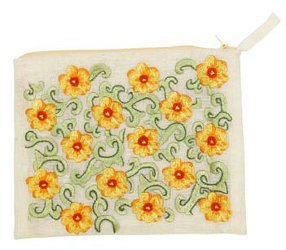Since February is National Embroidery Month we’re taking a look at the well-known craft that’s remained popular for centuries.
Embroidery starts when an outline is drawn on fabric and then stitched over with a back stitch. This will create a solid line in thread. Projects ranging from handbags to ornaments can include embroidery. Traditionally, embroidery was limited to being a hand-craft but with technological advancements, new computerized machines have modernized the craft.
One of the older forms of embroidery is Redwork. Here’s an article on Redwork Embroidery by our resident Craft Expert, Maria Nerius.
Does Redwork Make You See Red?
Image may be NSFW.
Clik here to view.
Redwork will have you seeing red only because it is created with a red cotton thread! It is a simple embroidery technique that is one of the most beloved traditional crafts. Redwork is believed to have originated in Europe in the 19th century. It is believed to have made its way to America before the Civil War by immigrants. This style of embroidery was most popular with the working classes as it was not out of their price range. It’s first popularity had much to do with its affordability, simplicity, and availability.
In the United States penny squares were sold; penny squares were 6” muslin square marked with a design that could be stitched. The square was sold for a penny and for an additional penny you could buy a skein of red thread. The squares were often used to create quilts, bedspreads and linens. The squares eventually went up in price, but folklore loves the origins.
The stitches and designs were simple enough for children to use to learn and improve their stitching skills. The designs were often no more than just the outline of a motif like a flower, dog, or child. You could purchase these squares at the local general store and by mail order from ads in catalogs, newspapers, and magazines. The popularity of Eedwork embroidery died done after WWII, but it can still be found in books, magazines, and online.
Materials Needed for Redwork:
- Red embroidery floss
- Fabric, traditionally plain cotton muslin
- Needle, small sharp
- Hoop, to hold the fabric in place while stitching
- Design, usually a transfer design
Additional Tips:
- Wash your muslin before you transfer your design or start stitching
- Redwork is simple and doesn’t translate well to fussy or overly detailed designs.
- Traditional Redwork designs included alphabets, samplers, farm animals, fruits, and holidays.
(Find a review of “Redwork from THE WORKBASKET” on AllFreeSewing.com)
Want to celebrate National Embroidery Month? Learn how to embroider and find free project ideas below.
Image may be NSFW.
Clik here to view.
Bottle Koozies
Image may be NSFW.
Clik here to view.
More Embroidery Projects:
Baby Girl Rattle Embroidery Design
Tea Set
Dancing Leaves Pillow
Easter Bunny Applique Pillow